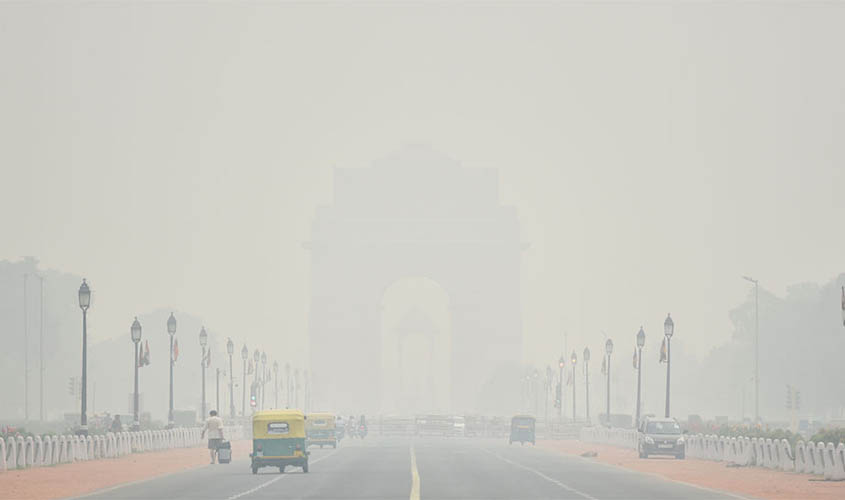Entire political class has become insouciant about air pollution issue. What still defines the system is thinking paralysis.
The term “gray rhino” entered the lexicon with a book by Michele Wucker in 2016, The Gray Rhino: How to Recognize and Act on the Obvious Dangers We Ignore. It implies a highly probable but still neglected threat or event. The November smog shrouding Delhi, along with large parts of North India, is one such threat that everybody knows everything about, but is helpless against.
The deadly air pollution is too noxious to be ignored. There is a medical emergency; millions of people suffer physically; hospitals report a surge in the number of weather-hit patients; India’s image is tarnished. And yet, even after so many years, with full awareness about the severity of the problem, nobody has been able to redeem the situation. For, the wish to do something concrete—by those who matter—is simply lacking.
There are either token measures or pro-forma statements by politicians. For instance, the efficacy of the Delhi government’s odd-even scheme is marginal to address the issue. According to the Central Pollution Control Board, cars constitute only 3% of air pollution in the capital, whereas all the vehicles combined contribute 28% to it. Yet, the scheme targeted only cars—and the Aam Aadmi Party, with an eye on the Assembly elections early next year, peddled the action as panacea for the problem.
It’s not that the Central government has anything better. Consider Union Environment Minister Prakash Javadekar’s statement on 15 November, “We were the first ones to start a joint action plan—short-term, medium-term, and long-term since 2015. There are challenges and we need to fight together. I’ve always said that joint cooperation is needed.”
The Honourable Minister seems to have ignored obvious questions his statement raises: What kind of joint action plan is this? Despite being so comprehensive—taking “short-term, medium-term, and long-term” aspects into consideration—why hasn’t it been able to end, or even reduce, air pollution in North India in four years? But our political masters have sunk themselves so deep in rhetoric that they sometimes ignore its obvious anomalies, incongruities, and absurdities.
Unsurprisingly, the entire political class has become insouciant about the air pollution issue. Nothing else explains the absence of 25 Parliamentarians of the 29-member Parliamentary Standing Committee from a high-level meeting that was supposed to be held over the subject on 15 November.
Typically, the officials followed suit. Delhi’s municipal commissioners, the Delhi Development Authority vice-chairman, and other top bureaucrats also gave the important meeting a miss. In fact, they didn’t even bother to inform the committee about their absence. Neither the executive nor the legislature is bothered about an important problem.
While politicians and bureaucrats can be accused of apathy, the root-cause pertains to the basic structure of the Indian political system. When the Congress-led United Progressive Alliance was in office, the term “policy paralysis” became popular. It was a wrong, misleading term; what defined, and still defines, the system is thinking paralysis. The institutional mindset has been so solidly cast in the statist crucible that it is unable to react to crises, environmental or economic, in a realistic manner.
At the heart of North India’s environmental crisis is the thought process that informs governance and economic policy. Dust, for instance, is a major contributor to air pollution. The authorities tend to deal it with in a simplistic, easy manner—e.g., stopping construction activity when air pollution peaks. The difficult but correct approach is to reduce the amount of dust generation, but that calls for fundamental changes in which the local officials function: making them more responsive and responsible, improving efficiency at various levels, checking corruption, covering dusty patches with vegetation, etc. All these require Job’s perseverance, not Caesar’s pomp and circumstance.
Similarly, at the heart of farm fires, another contributor to air pollution, lies free power to farmers, for this dangerously populist policy has facilitated the cultivation of rice in Punjab. Quite apart from physically hurting millions of people, crop burning has adversely affected soil and lowered the groundwater level.
It is worth noting here that all the solutions suggested and tried—e.g., subsidies on happy seeders—are essentially statist measures. Few among those who matter have suggested a relook at the root-cause—that is, free power to Punjab farmers. Even such a hint is misconstrued as an anti-farmer move.
In fact, such is the rigidity of institutional thinking that anything and anybody non-statist is cast aside. Arvind Panagariya, handpicked by the ruling dispensation to become the first head of Niti Aayog, is a case in point. A zealous votary of reforms in farm policy who wants the minimum support prices (MSPs) to go and market access for the agriculturist to increase, he quit before completing his term. The reason was simple: in India, governments don’t listen to its own advisers, especially if they are sensible.
Our leaders talk big: India is the world’s fastest growing economy, an emerging superpower, a Vishwaguru, et al. But one wonders how would a country that can’t tackle gray rhinos would confront black swans—that is, unexpected events that usually bring grief. The grandiloquence notwithstanding, we are sitting ducks.
Ravi Shanker Kapoor is a freelance journalist

